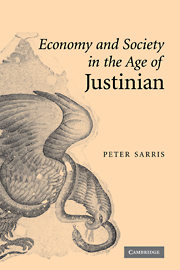Book contents
- Frontmatter
- Contents
- List of figures
- Preface
- Introduction
- 1 Egypt and the political economy of empire
- 2 The Apion archive: economic structure and estate accounts
- 3 Labour and administration: the evidence of the contractual papyri
- 4 Letters and petitions: social relations in the sixth-century Oxyrhynchite
- 5 The Apiones and their analogues
- 6 On the margins of magnate power: Dioscorus and Aphrodito
- 7 Landscapes of power: the great estate beyond Egypt
- 8 The historiography of the great estate
- 9 The great estate and the imperial authorities
- 10 The rise of the great estate
- 11 Economy and society in the age of Justinian
- Conclusion
- Bibliography
- Index
7 - Landscapes of power: the great estate beyond Egypt
Published online by Cambridge University Press: 24 July 2009
- Frontmatter
- Contents
- List of figures
- Preface
- Introduction
- 1 Egypt and the political economy of empire
- 2 The Apion archive: economic structure and estate accounts
- 3 Labour and administration: the evidence of the contractual papyri
- 4 Letters and petitions: social relations in the sixth-century Oxyrhynchite
- 5 The Apiones and their analogues
- 6 On the margins of magnate power: Dioscorus and Aphrodito
- 7 Landscapes of power: the great estate beyond Egypt
- 8 The historiography of the great estate
- 9 The great estate and the imperial authorities
- 10 The rise of the great estate
- 11 Economy and society in the age of Justinian
- Conclusion
- Bibliography
- Index
Summary
La plaine appartient au seigneur.
To the established families of Tripoli, the main city of north Lebanon and urban centre for Akkar, ‘the mountain’ is the epitome of unregenerate ‘tribalism’ and savage ‘backwardness’. The warrior figures of the Jurd with their upturned moustaches, rifles and bandoliers seem the very type of archaic traditionalism. They represent the polar opposite of city values and are the subject of a certain mocking humour. But to the people of the foothills and plain, the Jurd signifies something more precise, and more immediate: clanship, autonomous self-help, heavily armed men, forces to be feared and not easily restrained. Men of the higher villages sometimes ‘come down’ on the lower settlements in a raid or in furtherance of some political dispute. Most seriously, they can cut the water supply to the lower settlements. The state gives little protection against these mountain communities who live very different lives from the small cultivators and labourers. Only powerful lords such as the Minister can ensure that relations with the Jurd remain relatively stable.
INTRODUCTION
As seen in chapter five, the documentary papyri record the existence in fifth- and sixth-century Egypt of highly monetised and, by implication, highly commodified bipartite great estates owned by members of the late antique aristocracy of service. These estates were worked by agricultural workers, often resident on estate-owned settlements styled epoikia or choria, who split their time between allotments associated with these holdings (ktemata) and the centrally administered estate ‘in hand’ or demesne (the autourgia).
- Type
- Chapter
- Information
- Economy and Society in the Age of Justinian , pp. 115 - 130Publisher: Cambridge University PressPrint publication year: 2006

